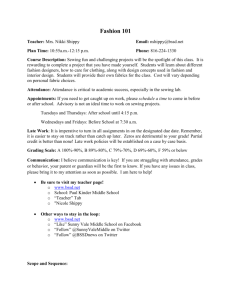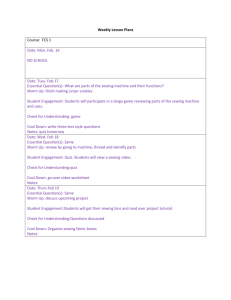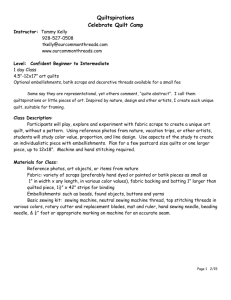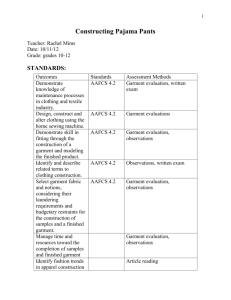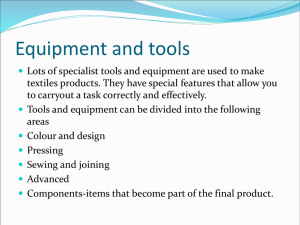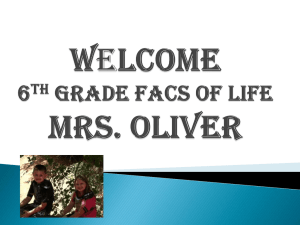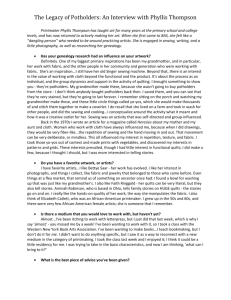Microsoft Word - 7035_ClothingI_PG.doc
advertisement
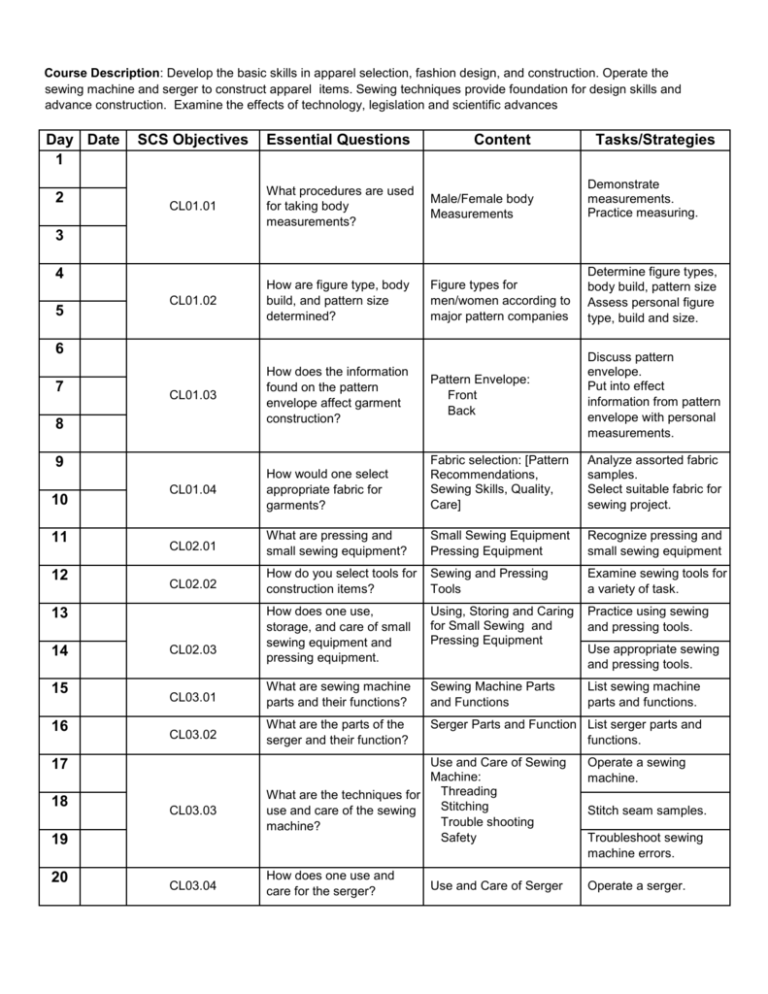
Course Description: Develop the basic skills in apparel selection, fashion design, and construction. Operate the sewing machine and serger to construct apparel items. Sewing techniques provide foundation for design skills and advance construction. Examine the effects of technology, legislation and scientific advances Day Date 1 2 SCS Objectives Essential Questions Content Tasks/Strategies CL01.01 What procedures are used for taking body measurements? Male/Female body Measurements Demonstrate measurements. Practice measuring. CL01.02 How are figure type, body build, and pattern size determined? Figure types for men/women according to major pattern companies Determine figure types, body build, pattern size Assess personal figure type, build and size. CL01.03 How does the information found on the pattern envelope affect garment construction? Pattern Envelope: Front Back Discuss pattern envelope. Put into effect information from pattern envelope with personal measurements. CL01.04 How would one select appropriate fabric for garments? Fabric selection: [Pattern Recommendations, Sewing Skills, Quality, Care] Analyze assorted fabric samples. Select suitable fabric for sewing project. CL02.01 What are pressing and small sewing equipment? Small Sewing Equipment Pressing Equipment Recognize pressing and small sewing equipment CL02.02 How do you select tools for construction items? Sewing and Pressing Tools Examine sewing tools for a variety of task. How does one use, storage, and care of small sewing equipment and pressing equipment. Using, Storing and Caring for Small Sewing and Pressing Equipment Practice using sewing and pressing tools. CL03.01 What are sewing machine parts and their functions? Sewing Machine Parts and Functions List sewing machine parts and functions. CL03.02 What are the parts of the serger and their function? Serger Parts and Function List serger parts and functions. 3 4 5 6 7 8 9 10 11 12 13 14 15 16 CL02.03 17 18 CL03.03 19 20 CL03.04 Use and Care of Sewing Machine: Threading What are the techniques for Stitching use and care of the sewing Trouble shooting machine? Safety How does one use and care for the serger? Use and Care of Serger Use appropriate sewing and pressing tools. Operate a sewing machine. Stitch seam samples. Troubleshoot sewing machine errors. Operate a serger. Day Date 21 22 SCS Objectives Essential Questions Content Threading Stitching Trouble shooting Safety Stitch seam samples and finishes. Troubleshoot serger errors. Pattern and guide sheet information: Pattern symbols Layout charts Sewing Instructions Practice identifying pattern symbols. Utilize information found on layout charts. Examine sewing instructions. How does one prepare the pattern and fabric for construction? Pattern and fabric preparation: Illustrate Fabric folds and placing on grain. Demonstrate pattern fit and fabric preparation. What are pinning, cutting, and marking procedures. Procedures: Pinning, Create simple tissue Cutting, Marking holder. CL05.01 How are basic seams and seam finishes constructed? Basic seams and seam Finishes: Plain Reinforced French Zigzag Serged Construct basic and French seam sample. Construct zigzag and Serged seam. Design a place mat using different seams and seam finishes. CL05.02 What pressing techniques are used in garment construction? Pressing: Pressing basics Pressing techniques Press seam samples open using appropriate techniques and equipment. Evaluate results. CL05.03 What are the ways to reduce bulk in plain seams? Reducing Bulk: Grading Clipping Notching Trimming Prepare sample facing and grade seam. Demonstrate use of clipping and notching Prepare samples of trimming. CL05.04 What are the ways to control fullness in garments? Controlling Fullness: Darts Easing Gathering Casing CL03.04 (Continued) 23 24 CL04.01 What information is found and used on the pattern and guide sheet? 25 26 27 Tasks/Strategies CL04.02 28 29 CL04.03 30 31 32 33 34 35 36 37 38 39 40 41 42 43 Mark, sew & press single /double pointed dart. Assess ways of fullness control in various patterns & make samples. 44 Day Date 45 SCS Objectives Essential Questions Content Discuss fasteners/ closures use and location 46 Demonstrate the central zipper application. Demo. Sample buttonholes/buttons. Construct samples of machine worked: Buttonholes/ buttons Zippers Hook/Eyes/loops Snaps CL05.05 What are the ways to apply fasteners and closures? Fasteners and closures: Zippers Buttons Machine-worked buttonholes Snaps Hook and eyes Hook and loop CL05.06 How are interfacings, facings, and waistband applications used? Interfacing, facings, and waistbands Types of interfacing Facing applications Waistband applications Construct a sample waistband w/interfacing. Construct garment inclusive of waistband, interfacing and facings. CL05.07 What are hemming techniques? Hemming techniques Machine Hand Demonstrate machine/ hand worked hems. Hem a garment. 47 48 Tasks/Strategies 49 50 51 52 53 54 55 56 57 58 59 60 CL05.08 How does one evaluate the Evaluate a Garment construction of garments? CL06.01 What factors influence clothing decisions? CL06.03 What factors affect readymade garment choice? What are clothing needs throughout the life span? CL07.01 What are methods of apparel and textiles care? CL07.02 What are methods of apparel and textiles repair? 61 CL06.02 62 63 64 CL08.01& CL08.02 65 What are apparel & textiles cleaning procedures Clothing Decisions Construct a garmentrating sheet. Evaluate garment using rating sheet. Explain how to figure true cost of a garment. Ready-Made Criteria Review ways to choose ready-made garments. Life Span Clothing Special Needs Clothing Role-play various physical challenges. Daily & Seasonal Care Storage Assess daily & seasonal care of garments. Repair Procedures Give examples of ways to repair garments. Textile Care Products Stain/Soil Removal Develop a laundry guide brochure. 66 CL09.01 What are traits of natural & man-made fibers? SCS Objectives Essential Questions CL09.01 What are traits of natural & man-made fibers? Fiber, Man-made & Blends What are the characteristics of fabrics? Using yarn, weave five of the basic weaves: Fabrics: Woven, Knitted, plain, basket, and Non-woven herringbone, sating and twill. Attach to note card and label. 67 Day Date 68 69 70 CL09.02 71 72 73 74 75 CL10.01 What are structural and surface designs? CL10.02 78 81 What is fabric finishes? CL11.01 How did Fashion evolve? Development of Style Influences of Fashion Discuss fashion from various eras of history. CL11.02 What is the fashion cycle? Terminology Fashion Cycle Discuss traits of the fashion cycle. CL12.01 What are the effect of line, color, and texture in clothing design? Effects on Clothing Design: Line, Color, Texture Create a color Wheel. Analyze texture and line movement of fashions. CL12.02 How does lines, shapes, and spaces create fashion Creating fashion: line, shapes and spaces Discuss lines, shape & space in fashion design. CL12.03 What are the elements and principles of design used in apparel? Elements in Apparel Principles in Apparel CL13.01 What are the strategies used in career preparation? Career Preparation 84 85 Identify design elements used in garments. Analyze design principles design used garments. Discuss way to prepare for a career. CL13.02 What are professional Job-Seeking Skills practices in the workplace? CL14.01 What are occupations & careers in the industry? Apparel & Textile Industry Careers Research Apparel & Textile careers. CL14.02 What are traits needed for success in A & T careers? Traits of Success Brainstorm solutions to various work scenarios. 86 87 Match finish types to the end use of products. Prepare a career plan based on you. Discuss importance of an interview & follow-up 82 83 Tasks/Strategies Research web for info. on new fibers. Identify fabric samples by design. 79 80 Content List characteristics of man-made/ natural fiber Structural [Woven, Yarn] Surface [i.e. Embroidered] Fabric Finishes-texture, Appearance/Performance 76 77 Fiber, Man-made & Blends Review/Exam 88 89 90


